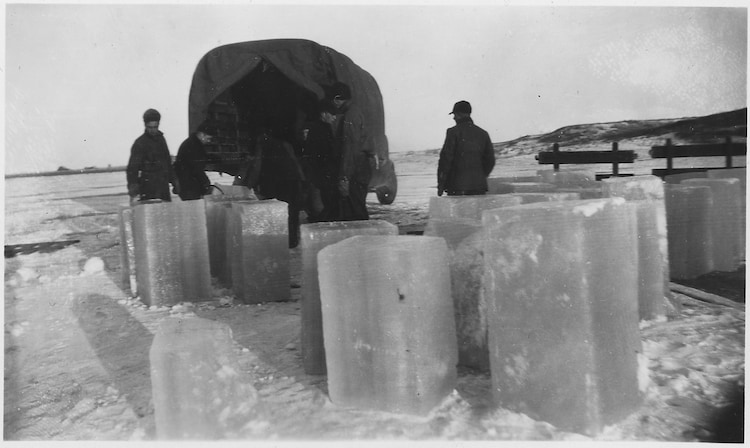Extreme heat in Britain at 26 degrees Celsius. How the British fled to the mountains to escape by sending snow to India
A news report said that Britain will have a scorching heat with temperatures reaching 26 degrees Celsius for 48 hours, leaving Indians scorching 40+ degrees. Many asked how the British ruled us for 200 years? British colonists brought ice to India, and made their home in cold areas to survive. Here is the story.

British tabloid The Mirror reported that Britain would experience heat of 26 degrees Celsius for 48 hours. This left Indians, who are already battling scorching heat with temperatures above 40 degrees Celsius, shocked.
Many people on social media platforms asked how the British stayed here and ruled us for 200 years.
The British colonised the whole world. They saw cracks in governance and took advantage of it to become rulers of the country. Nothing bothered them much except the weather in countries like India. Even today, the British get bothered by a little heat. As soon as the temperature reached 26 degrees Celsius, the British Met Desk called it a “heatwave”.
The weather forecast predicts that temperatures could reach 30 degrees Celsius at the end of June. These cities will see the worst weather: Birmingham, Cardiff, London, Manchester and Newcastle. A “heatwave” is expected from June 26 to June 28.
But Indians are justified in asking how the British endured the harsh summers to rule them for two centuries.
Although each country has its own limit of how much temperature it can tolerate, the British rule in India had a solution to the harsh summers here: ice was shipped to India’s mountainous regions.
Indians are shocked by the temperature of 26 degree Celsius in Britain
Indians read the forecasts published in the Mirror report and raised questions about how the British survived in such extreme temperatures during their 200 years of rule in India. This year the temperature in India has crossed 40 degrees. One X user, Bhivanasam, asked, “26°C is hot in the UK. I wonder how they survived Indian summers for 200 years.”
X user, madhvi_aggarwal, added a humorous twist to the forecast, “26 degrees Celsius is declared a heatwave for the UK, but for India, 26 degrees will officially be “let’s go out and eat chole bhature” weather.”
Another person, Kunal Biswas, tweeted, “Is 26 degrees Celsius a heat wave? In India it needs to be 40 degrees Celsius to call it a heat wave yet we act as if it’s nothing.”
While people on the internet are finding the weather forecast ridiculous, we saw how the British actually survived the summer in India.
The ice shipping empire of Frederic Tudor
Yes, there was a time when ice was sent to India.
Sailing across frozen waters around the world was a big business. British officers also went to hilly areas to escape the heat in India.
In the history of the British period in India, Frederic Tudor, a Boston entrepreneur, is at the forefront of discussions on the ice trade. The Boston Gazette even said about Tudor’s first voyage: “A ship carrying 80 tons of ice has left this port for Martinique. We hope this venture will not turn into a slippery speculation.”
I did not do it.
Tudor had figured out a way to ship ice abroad and make a lot of money from it. In 1833, he sent his first ship to Calcutta (now Kolkata). According to Atlas Obscura, it carried 180 tons of ice and Baldwin apples, which were from Massachusetts.
Four months later, a ship named Tuscany reached Calcutta. People gathered to see tons of snow. Some people even asked if this snow grew on trees.

J. H. Stockqueler, editor of The Englishman, was excited to see the barrels of ice and decided to buy some for himself.
Others even demanded that their money be refunded when they noticed that the ice on their palms had melted.
The ice trade had become successful. It also spread to Bombay (now Mumbai) and Madras (now Chennai). Huge ice houses began to appear in the presidencies of Bombay, Madras and Calcutta.
British summer capitals in the mountains
The British also used to go to hill stations to escape the harsh Indian summers.
Nainital, a major British hill station in Kumaon, formed from a flat land created by an 1885 landslide, became a favourite spot for officers seeking respite from the hot plains of India. In 1841, a British sugar merchant named P Barron visited Naini Lake, which is the centrepiece of Nainital. He built a house here.
The area around Naini lake began to be populated by the British, who built houses, churches, schools and administrative buildings. The city looked new with British-style architecture and planning.
It became the summer headquarters of the North-Western Province government and also a centre of education with the establishment of schools and a rich social life for British officers and their families.
Founded by the British in 1854, Dalhousie was named after Lord Dalhousie, the Governor-General of India who promoted the development of hill stations across India.
It was chosen due to its strategic location amidst the Dhauladhar range in the Chamba district of Himachal Pradesh, and was another station that offered respite from the high temperature places in India.
However, Shimla became the British summer capital in India due to its strategic isolation, aided by the Kalka-Shimla Railway, which ensured secure administration away from disturbances. It was further developed with the necessary infrastructure, hosting important government meetings until India’s independence in 1947.
#Extreme #heat #Britain #degrees #Celsius #British #fled #mountains #escape #sending #snow #India







